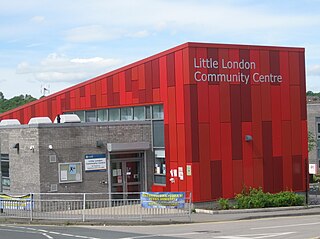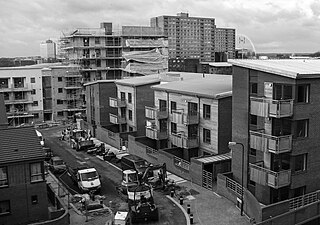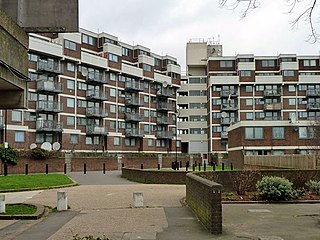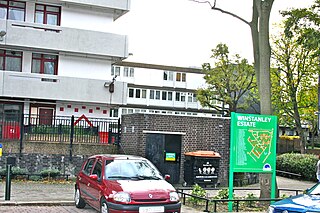
Brixton is an area of South London, part of the London Borough of Lambeth, England. The area is identified in the London Plan as one of 35 major centres in Greater London. Brixton experienced a rapid rise in population during the 19th century as communications with central London improved.

Harlesden is a district in the London Borough of Brent, North West London.

Little London is a residential area of Leeds in England, north of the city centre and Leeds Inner Ring Road. It is so called because in the 19th century it had fashionable housing and interesting architecture comparable to London. In the 1950s and '60s it became largely council housing and now consists of a mixture of high and low-rise flats and housing. The area falls within the Little London and Woodhouse ward of the City of Leeds Council. The area is divided into four estates; Lovell Park, Oatlands, Carlton and the Servias.

The Aylesbury Estate is a large housing estate located in Walworth, South East London.

Broadwater Farm, often referred to simply as "The Farm", is an area in Tottenham, North London, straddling the River Moselle. The eastern half of the area is dominated by the Broadwater Farm Estate ("BWFE"), an experiment in high-density social housing, loosely based on Corbusian ideas, dominated by concrete towers connected by walkways, built in the late 1960s using cheap but fire-vulnerable pre-fabricated concrete panels. The western half of the area is taken up by Lordship Recreation Ground, one of north London's largest parks. Broadwater Farm in 2011 had a population of 4,844. The estate is owned by Haringey London Borough Council.

Grahame Park, located on the site of the old Hendon Aerodrome in North West London, is a north London housing estate in the London Borough of Barnet, including 1,777 council homes built in the 1970s.
Muirhouse is a housing estate in the north of Edinburgh, the capital of Scotland.

Stonebridge is a locality in the London Borough of Brent. Stonebridge is situated in southern Brent and makes up the western part of Harlesden. The A404 runs through the district known locally as Brentfield and Hillside, while to the south are railway tracks and to the west is the North Circular Road along with Stonebridge Park station. The area is known for the previously troubled 1960s Stonebridge housing estate, which was completely redeveloped in the 2010s.

Loughborough Junction is an area of South London, in the London Borough of Lambeth, which is located equidistant between Brixton, Camberwell and Herne Hill.
South Acton is an area in Acton, West London, 6.4 miles (10.3 km) west of Charing Cross. At the 2001 census, Acton, comprising the wards of East Acton, Acton Central, South Acton and Southfield, had a population of 53,689 people.
The Peckham Boys, also referred to as Black Gang, is a multi-generational gang based in Peckham, South London. The gang is particularly prominent for its members prolific activity in music. Giggs, once a member of the SN1 set, is generally credited with popularising the British gangsta rap style known as road rap. Giggs would proceed to have a successful musical career, and re-form SN1 as a record label. In 2011, Peckham Boys rapper Stigs was given the first ever gang injunction, banning him from making any music that may encourage violence. Stigs was at the time allegedly a member of Anti GMG. In 2011, Southwark Council identified three sets of the Peckham Boys, PYG, Anti GMG and SN1, as the most active gangs in the Peckham area.

The Heygate Estate was a large housing estate in Walworth, Southwark, South London, comprising 1,214 homes. The estate was demolished between 2011 and 2014 as part of the urban regeneration of the Elephant & Castle area. Home to more than 3,000 people, it was situated adjacent to Walworth Road and New Kent Road, and immediately east of the Elephant & Castle road intersection. The estate was used extensively as a filming location, due in part to its brutalist architecture.
Church End, known locally as "Church Road", is a small locality in the London Borough of Brent, north of Harlesden, west of Willesden and south of Neasden. Its population is predominantly Afro-Caribbean.

Chalkhill Estate is located in the Wembley Park area of north-west London. It was originally one of three large council estates built in the London Borough of Brent by the early 1970s, along with Stonebridge and South Kilburn. The design was based on that of Park Hill in Sheffield. The high-rise estate was demolished by 2000 and gradually replaced by new low-rise builds.

Brent Cross Cricklewood is a new town centre development under construction in Hendon and Cricklewood, London, United Kingdom. The development is planned to cost around £4.5 billion to construct and will include 6,700 homes, workspace for 25,000 people, four parks, transport improvements and a 592,000 sq ft (55,000 m2) extension of Brent Cross Shopping Centre. The developers of the scheme are Hammerson and Standard Life.

The Carpenters Estate is located in Stratford, Newham, East London, close to the Queen Elizabeth Olympic Park. The estate is formed of low rise social housing and three tower blocks. The estate has been continually earmarked for demolition and redevelopment.

The Carlton Tavern is a pub in Kilburn, London, originally completed in 1921, that was illegally demolished in 2015 by Tel Aviv-based developer CLTX, which had failed to obtain the necessary planning permission. Westminster City Council subsequently ordered the pub to be rebuilt. It reopened on 12 April 2021. The pub was the only building in the street to survive the Blitz during World War II.

Public housing in the United Kingdom, also known as council housing or social housing, provided the majority of rented accommodation until 2011, when the number of households in private rental housing surpassed the number in social housing. Dwellings built for public or social housing use are built by or for local authorities and known as council houses. Since the 1980s non-profit housing associations became more important and subsequently the term "social housing" became widely used, as technically council housing only refers to housing owned by a local authority, though the terms are largely used interchangeably.

The Nightingale Estate is located in the Lower Clapton area of the London Borough of Hackney, next to Hackney Downs. The estate originally consisted of six 22 story tower blocks, but was redeveloped between 2003-2006 and replaced with mostly low-rise buildings. Only one of the towers, Seaton Point, still remains.

The Winstanley and York Road Estate comprises two large estates of predominantly public housing apartments in Battersea, London, adjacent to Clapham Junction railway station, although some have since passed into private ownership.

















